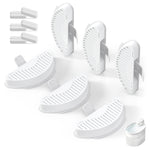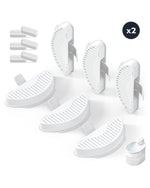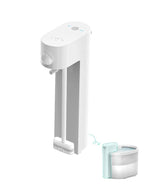Are you constantly sneezing, coughing, or dealing with itchy eyes at home? The culprit might be lurking in the air you breathe. An air purifier for allergies and pet dander could be the solution you’ve been searching for. In this comprehensive guide, we’ll explore how these devices work, their benefits, and how to choose the best one for your needs.
Understanding Allergies and Pet Dander
Allergies are a common issue for millions of people worldwide. They occur when the immune system overreacts to harmless substances like pollen, dust, or pet dander. Pet dander, in particular, is a major trigger for many individuals. It consists of tiny, even microscopic, flecks of skin shed by cats, dogs, rodents, birds, and other animals with fur or feathers. These particles can linger in the air and settle on surfaces, making it difficult to avoid exposure.
How Air Purifiers Help with Allergies and Pet Dander
Air purifiers are designed to remove contaminants from the air, including allergens like pet dander, pollen, and dust mites. They work by drawing in air, filtering out harmful particles, and releasing clean air back into the room. Here’s how they can make a difference:
- Capture Allergens: High-efficiency particulate air (HEPA) filters are highly effective at trapping allergens, including pet dander, pollen, and dust mites.
- Reduce Symptoms: By removing these irritants from the air, air purifiers can help alleviate allergy symptoms like sneezing, coughing, and itchy eyes.
- Improve Air Quality: Cleaner air can lead to better overall health, especially for those with respiratory conditions like asthma.
Key Features to Look for in an Air Purifier
When choosing an air purifier for allergies and pet dander, it’s important to consider several key features to ensure it meets your needs:
- HEPA Filter: Look for a purifier with a true HEPA filter, which can capture 99.97% of particles as small as 0.3 microns.
- Activated Carbon Filter: This type of filter helps remove odors and volatile organic compounds (VOCs), which can be particularly useful in homes with pets.
- Coverage Area: Ensure the purifier is suitable for the size of the room where it will be used.
- Noise Level: If you plan to use the purifier in a bedroom or office, consider one with a quiet operation.
- Energy Efficiency: Look for an Energy Star-certified model to save on electricity costs.
Tips for Maximizing the Effectiveness of Your Air Purifier
To get the most out of your air purifier, follow these tips:
- Placement Matters: Position the purifier in a central location, away from walls and furniture, to ensure optimal airflow.
- Regular Maintenance: Replace filters as recommended by the manufacturer to maintain peak performance.
- Keep Doors and Windows Closed: This helps prevent outdoor allergens from entering the room.
- Clean Your Home Regularly: Vacuum and dust frequently to reduce the amount of allergens in your environment.
Common Myths About Air Purifiers
There are several misconceptions about air purifiers that can lead to confusion. Let’s debunk some of the most common myths:
- Myth 1: Air Purifiers Eliminate All Allergens: While they are highly effective, air purifiers cannot remove 100% of allergens. Regular cleaning and other measures are still necessary.
- Myth 2: All Air Purifiers Are the Same: Different models have varying features and capabilities. It’s important to choose one that suits your specific needs.
- Myth 3: Air Purifiers Are Only for People with Allergies: Air purifiers can benefit everyone by improving overall air quality and reducing exposure to harmful particles.
Health Benefits Beyond Allergy Relief
While air purifiers are often associated with allergy relief, they offer a range of other health benefits:
- Improved Sleep: Cleaner air can lead to better sleep quality, especially for those with respiratory issues.
- Reduced Risk of Illness: By removing bacteria and viruses from the air, purifiers can help lower the risk of infections.
- Enhanced Mental Clarity: Breathing clean air can improve focus and cognitive function.
Environmental Impact of Air Purifiers
While air purifiers offer numerous benefits, it’s important to consider their environmental impact. Energy-efficient models can help reduce electricity consumption, and choosing a purifier with washable or recyclable filters can minimize waste. Additionally, maintaining your purifier properly can extend its lifespan, reducing the need for frequent replacements.
Choosing the Right Air Purifier for Your Home
Selecting the right air purifier can feel overwhelming with so many options available. Here’s a step-by-step guide to help you make an informed decision:
- Assess Your Needs: Determine the primary reason for purchasing an air purifier, whether it’s for allergies, pet dander, or general air quality improvement.
- Consider Room Size: Measure the room where the purifier will be used to ensure you choose a model with adequate coverage.
- Research Features: Look for features like HEPA filters, activated carbon filters, and quiet operation based on your priorities.
- Read Reviews: Check customer reviews and ratings to gauge the performance and reliability of different models.
- Set a Budget: Determine how much you’re willing to spend and compare options within your price range.
Frequently Asked Questions
Here are answers to some of the most common questions about air purifiers for allergies and pet dander:
- How often should I replace the filters? Most filters need to be replaced every 6 to 12 months, but this can vary depending on usage and the manufacturer’s recommendations.
- Can air purifiers remove pet hair? While air purifiers are designed to capture small particles like pet dander, they may not be as effective at removing larger particles like pet hair. Regular vacuuming is still necessary.
- Are air purifiers safe for pets? Yes, air purifiers are generally safe for pets. However, it’s important to choose a model with a quiet operation to avoid stressing your animals.
Ready to breathe easier and enjoy a healthier home environment? An air purifier for allergies and pet dander could be the game-changer you need. With the right device, you can reduce allergens, improve air quality, and enhance your overall well-being. Don’t wait—take the first step toward cleaner air today!












